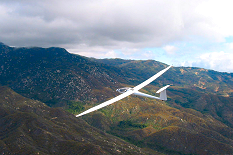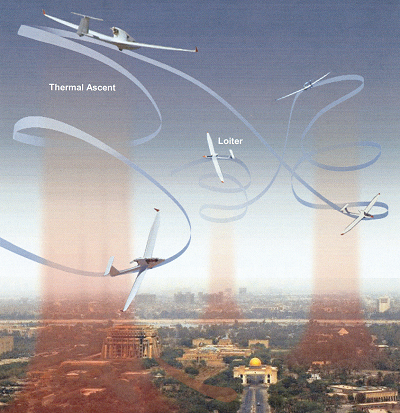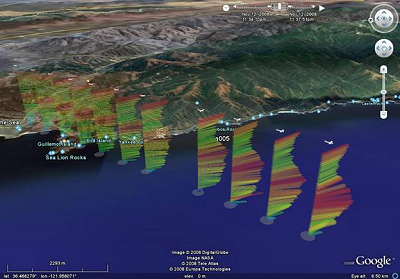![]() Sky Walker Endlessly Enduring Flight
Sky Walker Endlessly Enduring Flight
 |
|
Skywalker high endurance airframe, |
The Sky Walker Program is currently completing the initial phase of an $11M autonomous aerial vehicle research and development program funded by the Defense Advanced Research Projects Agency (DARPA).
Sky Walker aims to exploit ubiquitous energy in the atmosphere in the form of thermal and wind-induced updrafts in order to indefinitely extend the range and endurance of a highly aerodynamically efficient airframe.
Dr. James E. Hubbard, Jr., Samuel P. Langley Distinguished Professor from the University of Maryland, is the Primary Investigator for the effort. The program will pursue Dr. Hubbard's goal to use smart structures and smart skin technology to enhance the performance of modern air vehicles. The Sky Walker concept is biologically inspired and uses a unique proprietary sensing technology to emulate the enduring flight of the albatross. The grey headed albatross routinely circumnavigates the globe during its migration. These birds can make the 13,000 mile trip in about 48 days by exploiting energy available in the atmosphere. Sky Walker will use similar techniques of atmospheric energy exploitation in order to increase its range, endurance, and on-station persistence.

Concept of Energy Exploitation for Enduring Flight
The key enabling technologies being developed under the program are the lightweight and compact LIDAR system that allows the vehicle to ‘see’ the atmospheric conditions in front of the vehicle, as well as the conformal aerodynamic sensors on the wing surfaces that allow the vehicle to ‘feel’ the flow over its wings. Thus this vehicle will be able to both ‘see’ and ‘feel’ the wind as it flies. The ability to see the atmospheric conditions ahead allows Sky Walker to appropriately plan its flight path using intelligent algorithms in order to maintain or increase altitude as needed. The conformal aerodynamic sensors, when combined with Lift Distribution Control (LDC) algorithms and actuators, allow the vehicle to respond to arbitrary atmospheric conditions in real-time in order to maximize the efficiency of its wing for a wide variety of flight and mission scenarios.

Experimental LIDAR scan flight data showing wind direction, wind velocity,
and flight path overlaid on a 3D map of testing location
The Sky Walker Program is a collaborative effort between the University of Maryland’s Clark School of Engineering, the National Institute of Aerospace, NASA Langley Research Center, Aurora Flight Systems, Georgia Tech, and the Army Research Laboratory.
![]()

